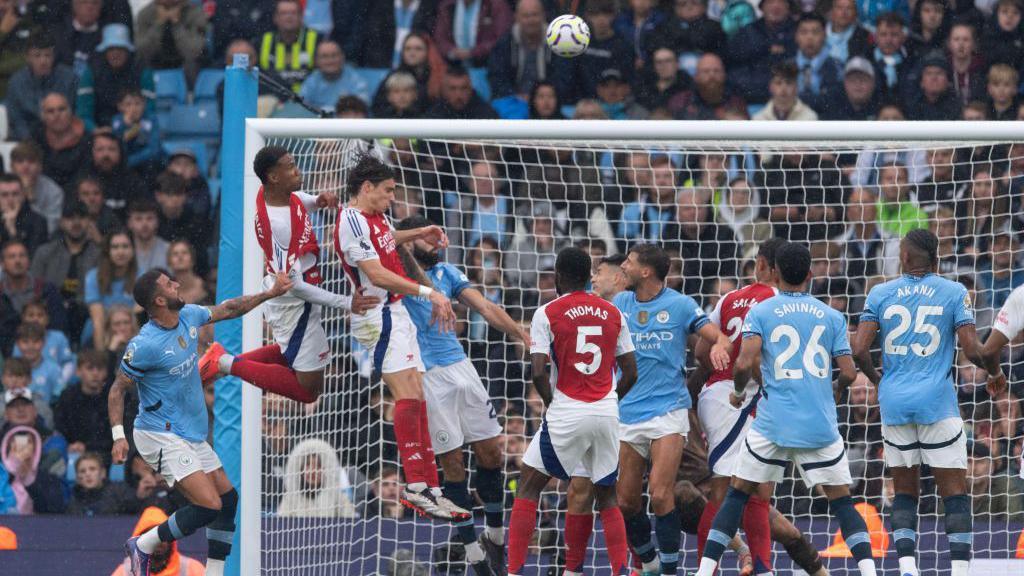Late goals, corners and fine margins – Premier League trends

Set-piece goals have become rarer over the years
-
Published
The Premier League season may only be 11 games old, but already it is shaping up to be a thriller.
There are plenty of storylines and narratives. Liverpool’s red-hot start, Manchester City and Arsenal’s faltering form and Manchester United already having changed their manager, top the agenda.
But what do the stats say? With the second international break of the season upon us, now feels like a good time to dig into the numbers.
Fine margins
The table is incredibly tight, with 13th place Manchester United – who have endured their worst-ever start to a Premier League season – on 15 points and just four behind Chelsea in third.
The Premier League table has never been this close after 11 matches.
At this time last season the gap between third and 13th was 11 points, slightly down from 12 in 2022-23.
In 2021-22 the difference was nine points, while in 2020-21 and 2019-20 the gaps were eight and 10 points respectively. This season’s four-point gap goes against the general trend.
Goals, goals, goals
There have been 314 goals scored in 110 Premier League matches this season, giving an average of 2.85 goals per game.
While that figure is down from the 3.28 goals that were scored per game last season, this season is on track to be the joint-second highest scoring Premier League season ever, tied with 2022-23.
The number of goals scored per game is generally trending upwards. The top five highest-scoring Premier League seasons have come in the past seven years.
Tottenham are the Premier League’s top scorers this season with 23 goals, just ahead of Man City and Brentford who have both scored 22.
Liverpool lead the way
Liverpool top the Premier League table with 28 points after 11 games, having won nine, drawn one and lost one.
Before this season, there have been 11 occasions of a team having 28 or more points after 11 games, with eight of those going on to win the title.
The only ones who didn’t were Newcastle United in both 1994-95 and 1995-96, and Arsenal in 2022-23.
The last time a team started a season better was in 2019-20, when Jurgen Klopp’s Liverpool won 31 points from their opening 11 games on their way to winning the title.
Clean sheets and goals conceded
Manchester United may well have had their worst start to a season in 38 years, but when it comes to keeping clean sheets they are doing rather well.
United have shut out their opponents on five occasions this term, with only Liverpool bettering them with six. United kept nine clean sheets in the whole of last season.
It’s the 15th time the Red Devils have kept five or more clean sheets in their opening 11 Premier League games. In seven of those seasons they went on to win the title, and their lowest finish was fifth in 2015-16.
Across Manchester, rivals City have struggled to keep their opponents at bay.
Guardiola’s side have only conceded one more goal (13) than United (12), but they have kept just two clean sheets in their first 11 league outings.
It’s their fewest clean sheets after 11 games since 2016-17 (two), which is the only other time a Guardiola side has kept two or fewer clean sheets after 11 top-flight games.
While we’re on the subject of defence, this season is the first since 2014-15 in which five of the previous season’s top six (Manchester City, Arsenal, Aston Villa, Tottenham Hotspur and Chelsea) have conceded an average of more than one goal per game after 11 matches.
Fashionable set-pieces
Set-pieces are in vogue, and for that we largely have Arsenal’s Nicolas Jover to thank.
However, the proportion of goals scored from set-pieces continues to trend downwards.
Jover is the Gunners set-piece coach and they have scored 27 goals (excluding penalties) in this manner since the start of last season, four more than any other Premier League side.
Similarly, their 19 goals from corners over the same period is four more than anyone else.
So far this season 20% of all goals scored in the Premier League have come from set-pieces (excluding penalties), a slight increase from 19.8% last season.
In 2021-22, 21.7% of goals came from set-pieces, but that fell to 21.3% in 2022-23. A decade ago, in 2014-15, 23.2% of Premier League goals were scored from set-pieces.
This season is on track to be the third lowest in terms of proportion of goals scored from set-pieces. 2020-21 (19.2%) is the lowest.
Comeback kings
It’s a bit of a cliche to fight until the end, but there is good reason to do so.
There have been 24 comeback wins (from at at least one goal or more behind) in the Premier League this season, accounting for 21% of all matches.
That figure has been trending upwards since 2021-22 (11.6%), with 2022-23 coming in at 15% and 2023-24 16.6%, the highest on record.
If this season continues in the same way, last season’s figure is set to be smashed.
Related topics
-
-
Published6 June
-





